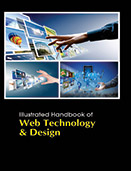Computer Science

Web designing is a process that can be done by anyone who has the right knowledge of the various disciplines involved but is usually best handled by professionals known as web designers. People are surfing the web and relying on web sites more than ever to research companies, compare offerings and form opinions about the brand. Expectations are high and will continue to grow as web design and technology become more sophisticated. People expect a business to have a web site that looks professionally designed and is filled with up-to-date, well-organized content.
Illustrated Handbook of Web Technology & Design gives aims to equip you with the basic skills needed to create website. You will learn how to design and produce basic web pages using the (X)HTML language and how to integrate them into a well-organized and user-friendly website. The book will also cover useful design tips and techniques to improve site, as well as how to put website on-line.
Certain components, such as graphic design or programming, are a part of any discussion, but their importance in the construction of sites varies from person to person and from site to site. Some consider the creation and organization of content—or, more formally, the information architecture—as the most important aspect of Web design. Other factors—ease of use, the value and function of the site within an organization’s overall operations, and site delivery, among many others—remain firmly within the realm of Web design. With influences from library science, graphic design, programming, networking, user interface design, usability, and a variety of other sources, Web design is truly a multidisciplinary field. Of course, the amount each aspect of Web design influences a site may vary according to the type of site being built. A personal home page generally doesn’t have the economic considerations of a shopping site. An intranet for a manufacturing company may not have the visual considerations of a public Web site promoting action movie.
The main focus of this Illustrated Handbook of Web Technology & Design is to obtain the skills necessary for them to understand the technologies related to web design and development.
The content in this book is appropriate for all levels of expertise—from professionals who need to look up a particular detail, to beginners who may require full explanations of new concepts and individual tags.